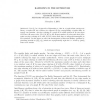Free Online Productivity Tools
i2Speak
i2Symbol
i2OCR
iTex2Img
iWeb2Print
iWeb2Shot
i2Type
iPdf2Split
iPdf2Merge
i2Bopomofo
i2Arabic
i2Style
i2Image
i2PDF
iLatex2Rtf
Sci2ools
103
click to vote
GC
2007
Springer
2007
Springer
Rainbows in the Hypercube
Let Qn be a hypercube of dimension n, that is, a graph whose vertices are binary n-tuples and two vertices are adjacent iff the corresponding n-tuples differ in exactly one position. An edge coloring of a graph H is called rainbow if no two edges of H have the same color. Let f(G, H) be the largest number of colors such that there exists an edge coloring of G with f(G, H) colors such that no subgraph isomorphic to H is rainbow. In this paper we start the investigation of this anti-Ramsey problem by providing bounds on f(Qn, Qk) which are asymptotically tight for k = 2 and by giving some exact results.
| Added | 14 Dec 2010 |
| Updated | 14 Dec 2010 |
| Type | Journal |
| Year | 2007 |
| Where | GC |
| Authors | Maria Axenovich, Heiko Harborth, Arnfried Kemnitz, Meinhard Möller, Ingo Schiermeyer |
Comments (0)

